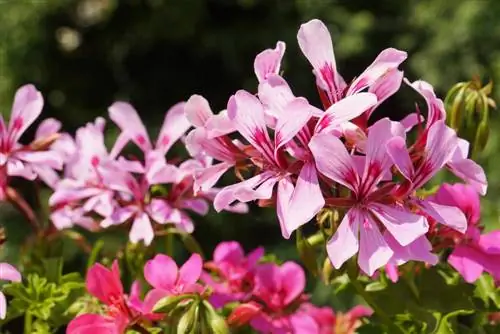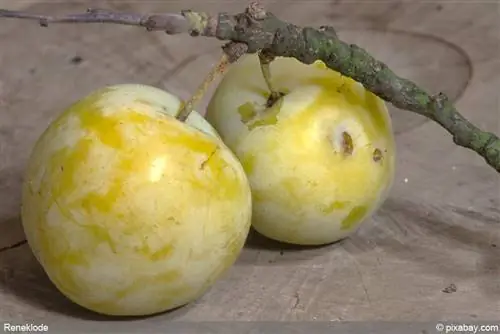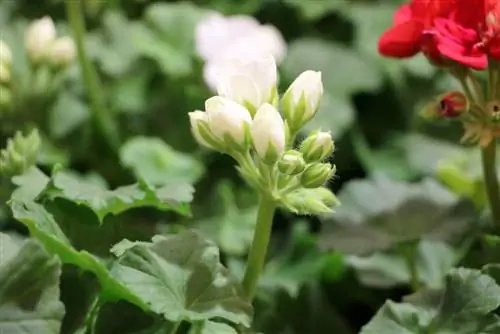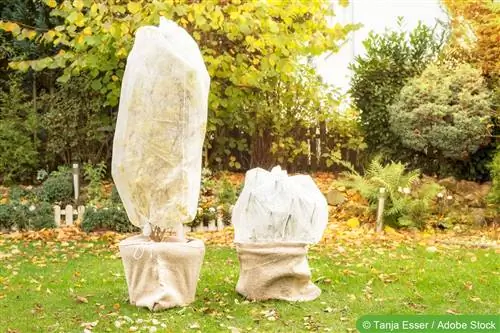- Author admin [email protected].
- Public 2023-12-17 03:39.
- Last modified 2025-06-01 06:48.
The Pelargonium grandiflorum enchants with its large, velvety flowers and, as an attractive houseplant, provides a true symphony of colors. As a lush-growing shrub, it is also wonderfully suitable for balconies and gardens if it is given a protected location. The wonderful ornamental plant is majestically beautiful and, growing to a height of up to 40 cm, shows its full splendor from spring to autumn. Noble geraniums are not hardy but perennial plants that do not require much care.
The ornamental plant from the cranesbill family (Geraniaceae) is considered a richly flowering beauty among geraniums in this country. Its lush green leaves and flowers, which shine in bright colors of red, pink and white with a dark spot, make it a unique eye-catcher in your home living environment. The first geraniums arrived in Europe from South Africa as early as the middle of the 18th century. Since then, new varieties and species have been created through breeding, including the noble geranium Pelargonium grandiflorum, which impresses with its striking, large flowers.
Location
The Pelargonium grandiflorum, also known as the noble or English geranium, prefers a bright, airy and warm location in summer, which under no circumstances should be in full sun. Noble geraniums can also be placed in a place protected from the rain in the garden, on the balcony or on the terrace. As a decorative plant, the impressive ornamental plant often decorates window sills. However, there should be good ventilation and dry, warm air should be avoided, for example near the radiator.
- bright to partially shaded location in summer
- outdoor a covered place that protects from rain
- no direct sunlight
- at temperatures of 15 to 20 °C
- in winter choose a bright and cooler place with 10 to 14 °C
- low temperatures between 12 and 14 °C promote flower development!
Tip:
If the noble pelargonium does not bloom, the reason for this is often a lack of light.
Substrate
The small bushes are thriving:
- on fresh to damp
- sandy-loamy garden soils
- as a pot culture is loamy soil or
- Ordinary substrate (standard earth) recommended, but provided with a drainage layer.
Pouring
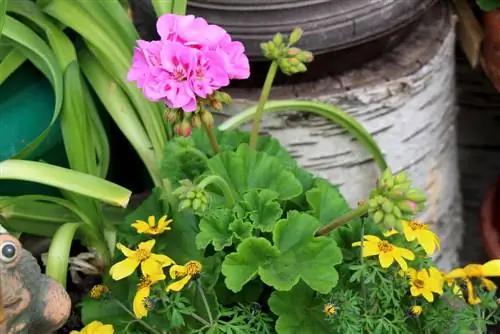
The small, colorful shrubs do not need a lot of water to grow lushly. Therefore, noble geraniums should only be watered moderately during the summer. In the winter months, when the plant is cooler, the soil must never dry out completely. That's why very little is watered during this time.
- water regularly and little in summer
- keep evenly moist.
- In winter, reduce watering to a minimum
- don't let it dry out
- Avoid waterlogging!
Tip:
To prevent root rot, make sure there is no water in the pot base. But soil or balls that are too moist can also promote rotting of the roots.
Fertilize
The Pelargonium grandiflorum is considered a highly consuming plant. That's why the fascinating ornamental shrubs should receive a liquid fertilizer every 2 to 3 weeks during the growing season, which is added to the irrigation water to prevent deficiency symptoms such as yellow leaves or flowers that are too small. In the winter months, however, fertilization should be avoided entirely.
- Use slow-release fertilizer
- or fertilize 1 to 2 times a month
- liquid complete fertilizer e.g. B. use for flowering plants or balconies and geraniums
Wintering
Noble geraniums are not hardy and are given suitable winter quarters, which they should move into before the first frost. However, compared to conventional balcony geraniums, the impressive ornamental plant requires a warmer location with temperatures of 12 to 13 °C. If the Pelargonium grandiflorum is to survive the cold season well, the temperature must under no circumstances fall below 8 °C!
- overwinter in bright rooms such as stairwells or cooler living rooms
- at room temperatures between 12 and 13 °C
- remove wilted leaves
- Check plants regularly for pests
- Never allow the substrate to dry out
Repotting and cutting
If necessary, the shoots can be cut back before transplanting. Since noble geraniums can beautify the home ambience for a long time, it is advisable to cut back the ornamental plants radically every now and then so that the richly flowering shrub retains its strength. Repotting into fresh potting soil or a larger container is done in spring.
Propagation

As a rule, the flowering of the plants decreases significantly from the third year onwards, so young plants should be taken care of in good time. In the fourth year at the latest, when the ornamental shrubs are only growing poorly and are slowly calcifying, propagation with cuttings is appropriate.
- Cut the head cutting around mid-August
- then leave it for a few hours so that the fresh interface can dry well.
- then plant the cutting in a mixture of sand and potting soil.
- rooting occurs after 15 to 20 days.
Tip:
Head cuttings of noble geranium should be planted in soil that has a soil temperature of 10 °C. Further cultivation then takes place at a soil temperature of 12 °C. If these values are exceeded, the plant will not produce any flowers.
Pests
Even if the Pelargonium grandiflorum receives the right care, whitefly or aphid infestation can still occur.
- Aphids: These pests mainly attack young leaf shoots and tender plant parts such as flower buds. They secrete honeydew, which attracts ants. In the case of light infestations, the spread of pests is contained by regular wiping and spraying with a detergent solution. If the infestation is more severe, spraying with insecticide is often the only thing that helps.
- Whitefly: Sucks the nutritious plant sap from the leaves, which then turn yellow, dry up and fall off over time. In addition to chemical agents, e.g. B. against scale insects, which contain pyrethrum and natural fatty acids and are therefore not harmful to the environment, this pest can also be combated with the so-called yellow stickers or yellow boards. Alternatively, there is a tried and tested home remedy that consists of a mixture of 1 liter of water and 30 g of soft soap and also helps with aphids.
- Gray mold: Excessive moisture (condensation) on flowers or leaves can cause gray mold to develop on the noble geranium, which comes from the genus of ascomycetes. In the event of this fungal infestation, diseased parts of the plant must be cut off immediately and he althy parts of the plant must be sprayed with a suitable fungicide.
Frequently asked questions
Are noble geraniums suitable for balcony boxes?
The Pelargonium grandiflorum can neither tolerate sharply fluctuating temperatures, as they usually prevail in summer, nor excessive humidity. Therefore, planting in balcony boxes is generally not recommended.
Can the plants be propagated with seeds?
Since this variety is a crossed breed, the popular ornamental plants are primarily propagated via cuttings. Because the seeds are rarely true to the variety.
Does the ornamental plant also bloom in winter?
If noble pelargoniums are to develop flowers in winter, a little skill is required. Because then the plants have to be kept either cool or dark for a while.
Noble geraniums - care tips
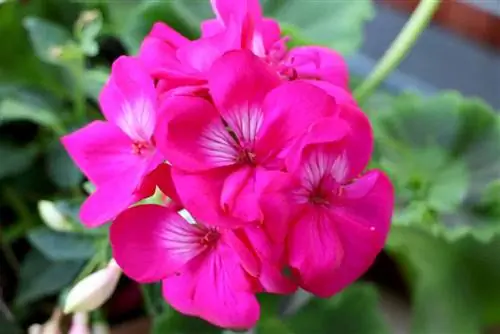
The Pelargonium grandiflorum is a houseplant that
- a rich bloom from April to early autumn
- developed in a bright, partially shaded location.
- Protected from the rain in a bucket, it is also suitable for balconies and gardens.
- You should avoid direct sunlight and waterlogging.
- In summer it is watered little but regularly.
- Only moderate in winter.
- Weekly fertilization is recommended.
- Propagation through cuttings is successful.
- Geraniums are not frost hardy.
- They overwinter at 12 to 13 °C in a bright location.
- Pests such as whiteflies and aphids often attack the plants.
What you need to know about geraniums in brief
A look into the balcony boxes also shows us that the bright red, pink or delicate purple geranium varieties are still favoured. In recent years, beautiful new products with delicate pastel shades have come onto the market. Likewise salmon-colored varieties that can be combined excellently with all possible shades of blue. It's just fortunate that at least the scented pelargonium group is finding an increasingly enthusiastic fan base.
Winter Care
Most plants survive the dangers of the long winter break better if you cut them back before putting them away. For pelargoniums (geraniums), all flowers, buds and some of the leaves are removed. All shoots are cut back by a third. This not only saves space, but also gives the plants air, making them better able to ward off diseases and pests. Pelargoniums are overwintered in a light and cool place. A place by the room window is also possible. Water if necessary. If you don't have the space or time to care for your geraniums in the winter, you'll definitely enjoy this type of wintering:
- Take the plants out of the boxes, remove thin shoots completely and shorten the main shoots.
- Remove the soil completely from the root ball and also cut back the roots.
- Wrap one plant at a time in newspaper, tie it up and hang it up in the cellar.
The advantages of this method: After the work is done, you can leave your geraniums to their own devices. In March they are unpacked and potted.
Geranium diseases
- Geranium rust: If brown spots appear on the undersides of geranium leaves, these are caused by fungi. At the first sign, all affected parts of the plant must be cut off. At the same time, the plants should be kept a little drier. Then spray with a fungicidal agent (fungicide). But beware! These preparations are very toxic.
- Geranium wilt: With geranium wilt, the leaves wilt before they then wither. The cause of geranium wilt is bacteria. Unfortunately, there is still no effective remedy against it. You must throw the plants away, but not into the compost.
Geranium fertilizer
Geraniums are also hungry and need enough fertilizer. Because only if the necessary supply of nutrients works can you enjoy lush flowers. Specialist retailers offer special geranium soil with a high nutrient content. If you can't buy this special soil in your area, then just use good potting soil with slow-release fertilizer. These packages also tell you when you need to add additional fertilizer. Special geranium fertilizer is ideal, the composition of which is tailored precisely to the needs of the plants. As an alternative, you can of course also use fertilizers for flowering balcony plants.

